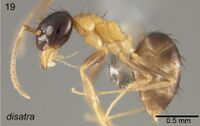Nylanderia disatra
| Nylanderia disatra | |
|---|---|

| |
| Scientific classification | |
| Kingdom: | Animalia |
| Phylum: | Arthropoda |
| Class: | Insecta |
| Order: | Hymenoptera |
| Family: | Formicidae |
| Subfamily: | Formicinae |
| Tribe: | Lasiini |
| Genus: | Nylanderia |
| Species: | N. disatra |
| Binomial name | |
| Nylanderia disatra LaPolla & Kallal, 2019 | |
Collection records show this is a ground nesting species. They have been found in the soil and inhabiting downed wood in and under the leaf-litter in moist forest, including highly disturbed areas. The type specimens were found in a coffee plantation.
Identification
LaPolla and Kallal (2019) - Head and gaster dark brown, contrasting sharply with yellow antennae, mesosoma and legs; macrosetae on mesosoma dark brown contrasting sharply with yellow mesosoma.
Compare with: Nylanderia semitincta
This is a strikingly colored species (seen in all three castes, but most muted in the queen), and therefore is easy to separate from all other New World Nylanderia known to date. Nylanderia semitincta from Puerto Rico is similarly colored with the head distinctly darker brown (not as dark as in N. disatra), as are the pronotum and gaster, contrasting with the yellow propodeum and legs.
Keys including this Species
Distribution
Latitudinal Distribution Pattern
Latitudinal Range: 19.35222° to 19.29529°.
| North Temperate |
North Subtropical |
Tropical | South Subtropical |
South Temperate |
- Source: AntMaps
Distribution based on Regional Taxon Lists
Neotropical Region: Dominican Republic (type locality).
Distribution based on AntMaps
Distribution based on AntWeb specimens
Check data from AntWeb
Countries Occupied
| Number of countries occupied by this species based on AntWiki Regional Taxon Lists. In general, fewer countries occupied indicates a narrower range, while more countries indicates a more widespread species. |

|
Estimated Abundance
| Relative abundance based on number of AntMaps records per species (this species within the purple bar). Fewer records (to the left) indicates a less abundant/encountered species while more records (to the right) indicates more abundant/encountered species. |

|
Biology
Castes
Male
Nomenclature
The following information is derived from Barry Bolton's Online Catalogue of the Ants of the World.
- disatra. Nylanderia disatra LaPolla & Kallal, 2019: 414, figs. 19-27 (w.q.m.) DOMINICAN REPUBLIC.
Unless otherwise noted the text for the remainder of this section is reported from the publication that includes the original description.
Description
Worker
Measurements (n=11): TL: 1.80–2.40; HW: 0.51–0.54; HL: 0.59–0.62; EL: 0.14–0.16; SL: 0.68– 0.72; WL: 0.71–0.78; GL: 0.50–0.99. SMC: 20–32 PMC: 2–4; MMC: 2–4. indices: CI: 81–89; REL: 23–27; SI: 129–139; SI2: 20–24. Head: sides of head in full face view rounded and slightly convergent anteriorly; posterolateral corners rounded; posterior margin straight and slightly emarginate medially; anterior clypeal margin evenly rounded; ocelli absent; eye well-developed. Mesosoma: in lateral view, pronotum subangular; anterior margin of mesonotum raised slightly above posterior pronotal margin; metanotal area without a short flat area before spiracle; dorsal face of propodeum distinctly convex; dorsal margins of propodeum and mesonotum approximately even in lateral view. Color and pilosity: Head and gaster dark brown to almost black, contrasting strongly with yellow mesosoma and petiole; antenna, mandible and legs yellow to brown-yellow; mesocoxa and metacoxa often whitish-yellow; macrosetae distinctly dark brown; scape and legs with layer of pubescence; head, mesosoma and gaster lack pubescence.
Queen
Measurements (n=1): TL: n/a; HW: 0.74; HL: 0.74; EL: 0.27; SL: 0.84; WL: 1.4; GL: n/a. SMC: 16; PMC: 3; MMC: 15. indices: CI: 100; REL: 36; SI: 113. Generally, as in worker with modifications expected for caste and with the following noted differences: mesosoma coloration darker brown than in worker, and with distinct yellow color along segmental margins
Male
Measurements (n=4): TL: 2.0–2.1; HW: 0.50–0.52; HL: 0.51–0.53; EL: 0.20–0.22; SL: 0.61–0.65; WL: 0.78–0.87; GL: 0.72–0.75. SMC: 4–9; PMC: 0; MMC: 8–9. indices: CI: 94–102; REL: 36–43; SI: 118–129.
Head: sides of head in full face view distinctly broader posterior to eyes; posterior margin rounded; clypeus evenly rounded anteriorly; mandible with 2 teeth, a long, distinct apical tooth and much smaller subapical tooth adjacent to apical tooth; basal angle sharp and distinct; Mesosoma: in lateral view, dorsal margin of mesoscutum same as height as dorsal margin of mesoscutellum; propodeum without distinct dorsal and declivitous faces. Genitalia: gonopod apex triangular but broadly rounded in lateral view; in dorsal view, gonopod margin curves away from penial sclerite; digitus with pointed apex that bends away from penial sclerite; cuspis tubular, rounded at apex bending sharply toward digitus; anteroventral process of penial sclerite coming to a point; valvura of penial sclerite placed approximately at midline (fig. 105). Color and pilosity: head and gaster dark brown, contrasting strongly with yellow mesosoma and petiole; antennae, mandibles and legs yellow to brown-yellow; mesocoxae and metacoxae often whitish-yellow; smooth and very shiny; scapes and legs with layer of pubescence; head, mesosomal notum and gastral tergites II-IV with dense pubescence.
Type Material
Holotype worker, DOMINICAN REPUBLIC: near Reserva Científica Ebano Verde, 19°01.10’ N, 70°31.86’ W, elev. 1139 m, coffee plantation, 30.vii.2009, J.S. LaPolla & S.A. Schneider (USNMENT00753609) (National Museum of Natural History); 5 paratype workers with same locality data as holotype (specimens are from the same nest as holotype) (NMNH & Museum of Comparative Zoology).
Etymology
Species epithet is a combination of atratus (L. = darkened) with the prefix dis- (L. = separate), named for the contrasting appearance of this species.
References
- LaPolla, J.S., Kallal, R.J. 2019. Nylanderia of the World Part III: Nylanderia in the West Indies. Zootaxa 4658 (3): 401–451 (doi:10.11646/zootaxa.4658.3.1).
- Williams, J.L., Zhang, Y.M., Lloyd, M.W., LaPolla, J.S., Schultz, T.R., Lucky, A. 2020. Global domination by crazy ants: phylogenomics reveals biogeographical history and invasive species relationships in the genus Nylanderia (Hymenoptera: Formicidae). Systematic Entomology 45, 730–744 (doi:10.1111/syen.12423).
References based on Global Ant Biodiversity Informatics
- LaPolla J. S., and R. J. Kallal. 2019. Nylanderia of the World Part III: Nylanderia in the West Indies. Zootaxa 4658: 401-451.


